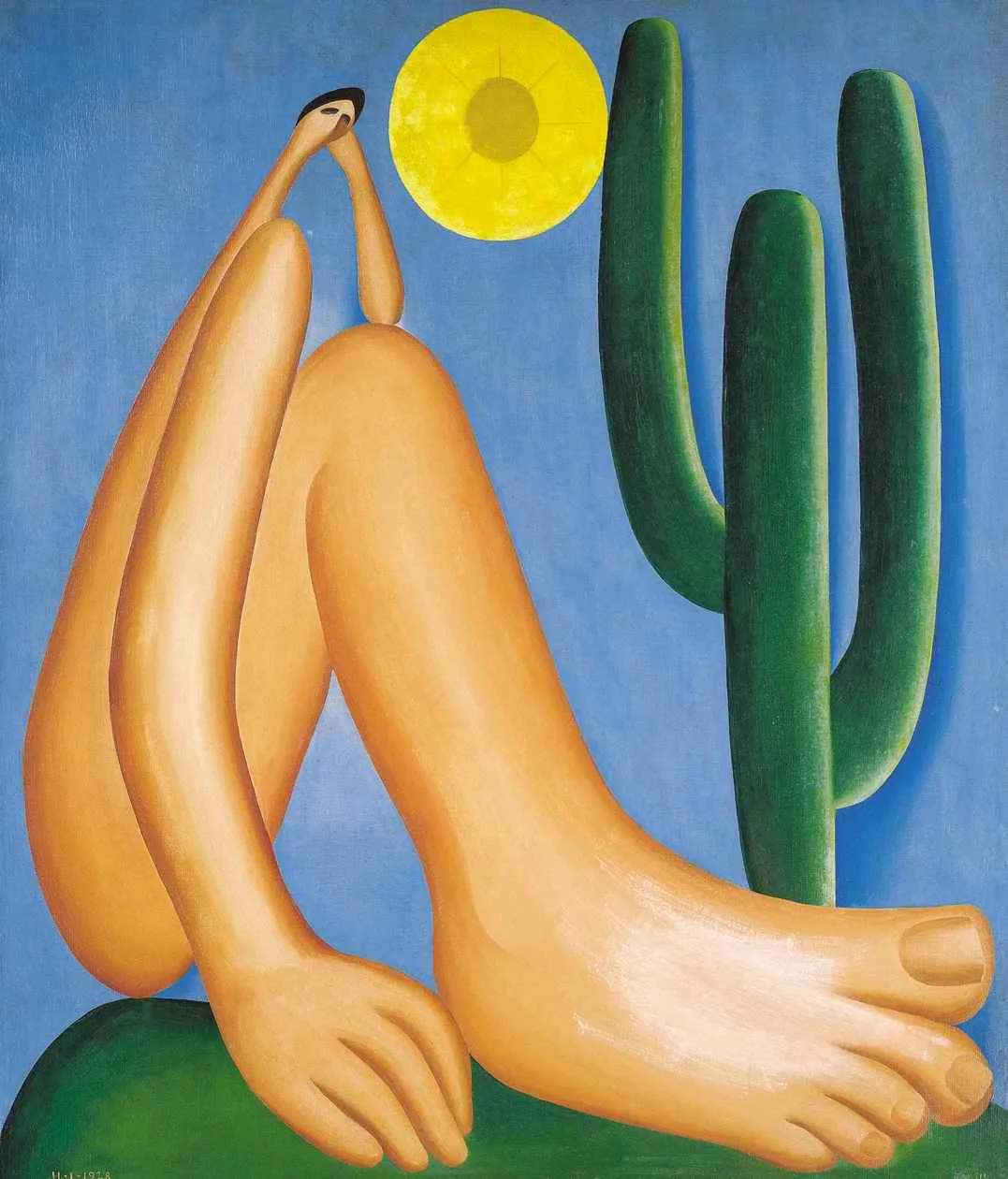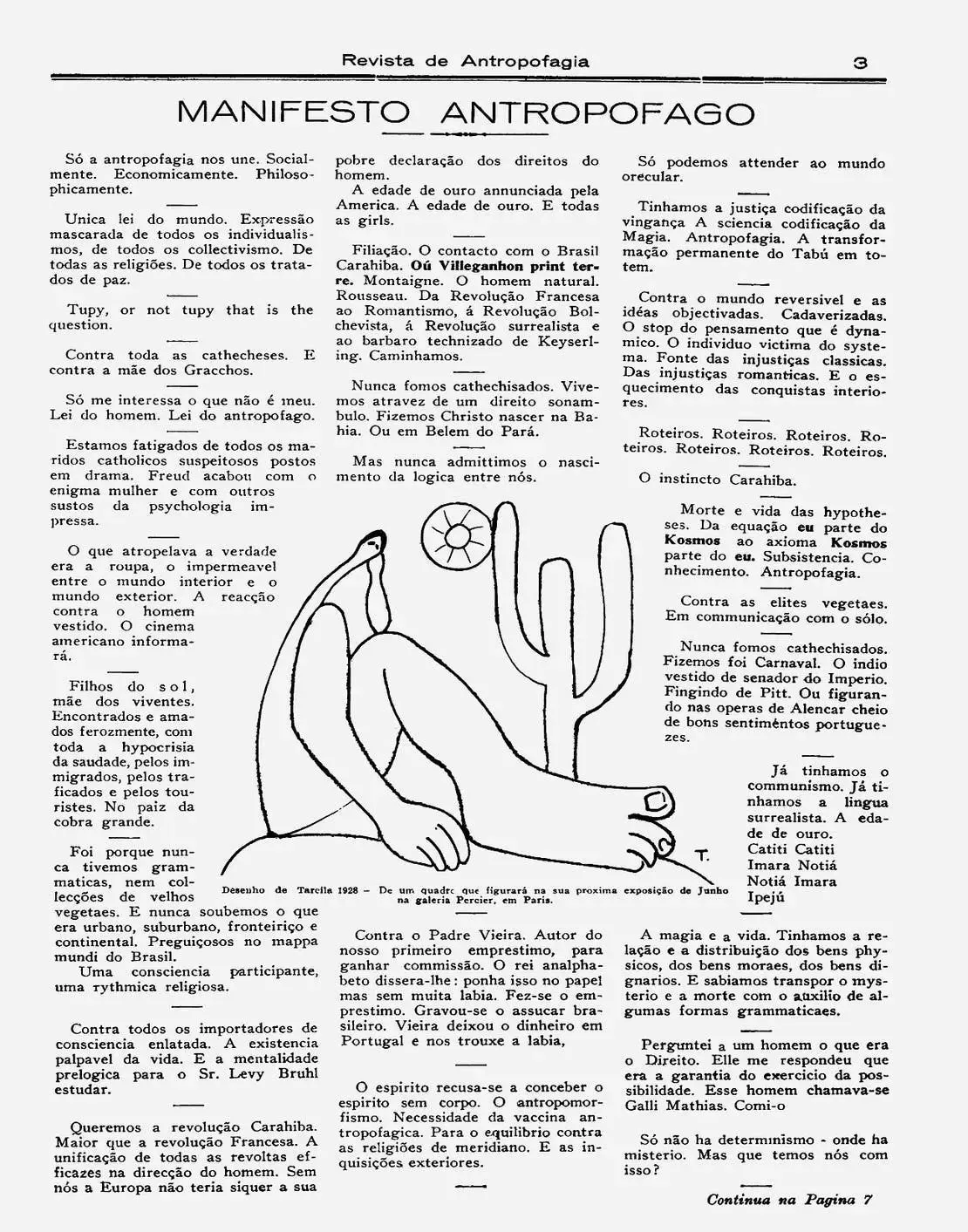 Tarsila do Amaral. Anthropophagy (Antropofagia), 1929. Oil on canvas, 49 5/8 x 55 15/16 in. (126 x 142 cm). Acervo da Fundação Jose e Paulina Nemirovsky, em comodato com a Pinacoteca do Estado de São Paulo. © Tarsila do Amaral Licenciamentos.
Tarsila do Amaral. Anthropophagy (Antropofagia), 1929. Oil on canvas, 49 5/8 x 55 15/16 in. (126 x 142 cm). Acervo da Fundação Jose e Paulina Nemirovsky, em comodato com a Pinacoteca do Estado de São Paulo. © Tarsila do Amaral Licenciamentos. In 1922, Brazil was not only celebrating a century of independence from Portugal—it was also witnessing the beginning of a new era for its art and culture.
Alongside government-organized celebrations, the Week of Modern Art (Semana de Arte Moderna) took place, featuring performances, art-making events, presentations, lectures, and poetry readings. Among its many participants was poet Oswald de Andrade (1890-1954), who, influenced by this cultural shift, would go on to write the Manifesto Antropofágo (1928), a foundational text of Brazil’s modernist movement.
The Week of Modern Art inaugurated modernism in Brazil, and Andrade's text gave it theoretical form by advocating for a new, independent Brazilian culture and identity. Almost a century after its first publication in the Revista de Antropofagia, the manifesto continues to challenge cultural paradigms and offer insights not only into the cultural context of post-colonial Brazil but also into global debates on cultural appropriation, identity, and decolonization.

With the rise of modernism, São Paulo became Brazil's new artistic center, drawing an influx of immigrants who enriched its cultural landscape. In contrast to Rio de Janeiro, which remained more conservative and traditional, São Paulo became a stage where artists tested new forms and radical innovative approaches, which would become a trademark of Brazilian art in the subsequent decades.
Although the modernists wanted to create new art and make a break from the past, European influences are nonetheless felt in their work. Understandably, as many Brazilian families had close ties with Europe and had familial connections with the old continent. Many Brazilian artists also studied in Paris and other artistic centres, learning firsthand about European avant-garde movements such as Cubism, Dadaism, and Surrealism, but also engaging with broader debates on national identity and cultural renewal in the aftermath of World War I. These experiences allowed them to break free from rigid academic traditions and envision a uniquely Brazilian modernist art. Among them were Anita Malfatti and Tarsila do Amaral, both key figures in Brazilian modernism, who synthetised foreign modernist techniques with national themes.
Tarsila do Amaral's classic painting of Brazilian modernism, Abaporu (1928), which she gifted to her husband Oswald de Andrade, is considered to have sparked in Oswald the idea for the Anthropophagic Movement. The name of the painting, derived from the Tupi-Guarani languages, means 'man who eats people' (aba – man, pora – people, and ú – to eat).
The work, featuring a human figure with disproportionately large feet and hands, the sun, and a cactus, also marks the anthropophagic phase in Amaral's oeuvre, characterized by strong colours and imaginative themes. The elements of the painting—green, yellow, and blue, which are also present on the Brazilian flag, along with the cactus, typical of Brazil’s dry regions—transform the image into a symbol of Brazilianness.
The artist herself confirmed her attachment to the land in a 1924 correspondence:
"I feel more and more Brazilian: I want to be the painter of my land. I am so grateful to have spent my entire childhood on the farm. The memories of that time are becoming precious to me."
Brazilian modernism was not just an aesthetic movement that rejected the rigid academism of the Brazilian Academy of Letters; it was also characterized by a greater awareness of the country's social issues and political currents. Brazilian modernists critically examined the influence of the United States and Europe on Brazilian art and culture, leading to the emergence of two distinct schools of thought.
On one side were the Nationalists, led by writer Plínio Salgado, who completely rejected foreign influences and advocated for an essentialist Brazilian identity. Salgado later founded the Integralist movement, Brazil's most prominent fascist organization, and attempted a coup against President Getúlio Vargas. On the other side were Oswald de Andrade and the Anthropophagics (Cannibals), who argued that Brazilian art should 'consume' and transform foreign influences into something distinctly Brazilian. The Anthropophagic movement, inspired by Andrade's Manifesto Antropófago, was not just an artistic endeavor but also a literary and philosophical one, challenging colonialist cultural hierarchies and envisioning a hybrid, dynamic national identity.

Oswald de Andrade's Manifesto Antropofágico (The Anthropophagic Manifesto) had its predecessors in other avant-garde manifestos and declarations of the period, including poet Mario de Andrade's Extremely Interesting Preface (Prefácio interessantíssimo) to his poetry book Paulicéia Desvairada (São Paulo Amazed), a literary theory that explains the aesthetics that would underpin the modernist movement. However, Oswald's piece gained more popularity for its broader scope of being not just a literary but a manifesto of cultural resistance as well.
In the text, Andrade rejects the idea that Brazilian culture was merely derivative of European traditions, and proposed a model of 'canibalism,' a process of absorbing foreign influences and transforming them into unique Brazilian culture.
“Only Cannibalism unites us. Socially. Economically. Philosophically.”
This bold claim sets cultural anthropophagy as a strategy of liberation, opposing the imperial logic that views Brazilian culture as imitative. Instead, Andrade foregrounds the figure of the cannibal, the one who 'devours' European and Western culture, incorporating it into the native self.
The manifesto is filled with obscure references and joking about Brazilian history making it a challenging read for those unfamiliar with its historical and literary allusions.
"The spirit refuses to conceive a spirit without a body. Anthropomorphism. Need for the cannibalistic vaccine. To maintain our equilibrium, against meridian religions. And against outside inquisition."
Passages similar to this abound in the manifesto, revealing the complexity behind the processes of identity-building in a post-colonial context.
One of the most famous declarations in the manifesto, "Tupi or not tupi that is the question," carries a double significance. It mentions the Tupí Indians, known for their ritualistic cannibalism—they ate their enemies believing that would give them strength—and also plays on the famous Hamlet's soliloquy. In itself, the phrase becomes the manifestation of cultural cannibalism Andrade propagated.
Drawing on Freudian theory of the development of the male child and the construction of its Other, Andrade's text makes parallels between Brazilian patriarchal society and Freud's figure of the Father, advocating for a utopian matriarchy liberated from repression and conflict. It is a symbolic agitation for a new social order and an overthrow of the "modus vivendi captialista," deriving from the Western white male experience.
However, despite referring to the Mother, Andrade's utopia largely excludes real women, as literary scholar Beth Vinkler explains. While the Mother is the Other of the capitalist patriarchy introduced by the Portuguese, the female principle remains "suppressed within the anthropophagic discourse." The anthropophagic utopia, she argues, "approximates a communist state designed to liberate men from the social ills brought about by capitalism and private property," a position Andrade will further develop in his later works.
Structurally, the piece also rejects the linearity of discourse inherited from European colonists, demonstrating that different epistemologies could be found in different discursive strategies.
The dualities that Andrade explores in the manifesto —primitive/modern, derivative/original, and civilized/barbarian—have currency in many of the present cultural debates as well.
Andrade's strong position on appropriation, turning it into a political act of resistance for indigenous and colonized people, has become a hallmark of many contemporary artistic investigations. Emerging from a specific context of national building, Andrade's concept of cannibalism has evolved into a political tool for creative self-expression and an egalitarian gesture that equalizes cultural production from different traditions. It embraces Brazilian culture that combines indigenous and African heritage, and also 'digests' European and Western cultural models.
Inspired by Freud and Marx, Andrade created a completely unique approach to defining national culture that inspired other artists—in the 1960s it influenced the Tropicália movement, led by musicians Caetano Veloso and Gilberto Gil, and in 1990, Brazilian artist Antonio Peticov installed a mural celebrating Andrade and the manifesto in a São Paulo's metro station.
Contemporary Brazilian artist Adriana Varejão is directly inspired by anthropophagy in appropriating European artistic traditions while exposing colonial violence in her work. Similarly, Afro-Brazilian and Indigenous artists also revisit Andrade's ideas to reclaim their cultural agency and identity.
In the domain of theory, Andrade's ideas found resonance in Homi Bhabha's writings on cultural hybridity as a form of resistance.
Almost a century after its publication, Andrade's Manifesto Antropofágo remains a relevant and radical text that rejects the still-prevalent notions of cultural purity and colonial logic, offering an alternative vision of constantly evolving and fluid identity. As Brazil, and the world for that matter, continue to grapple with these ideas, Andrade's vision of anthropophagy remains not just an artifact of historical writing, but also a living strategy for cultural self-determination and survival.